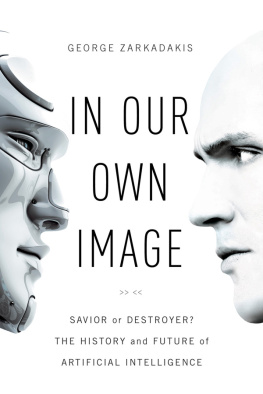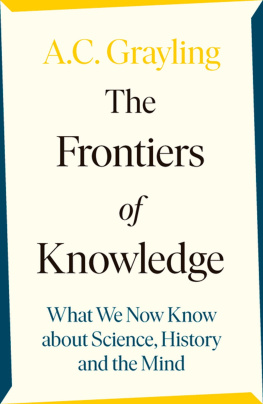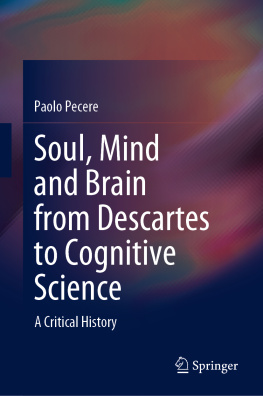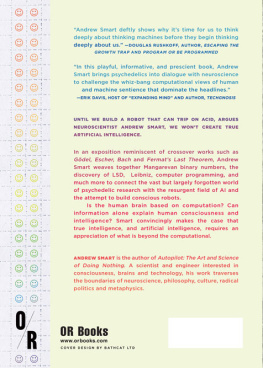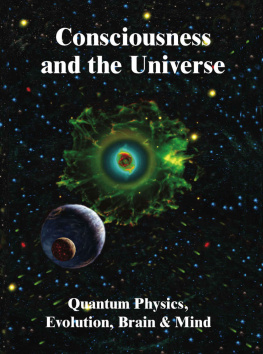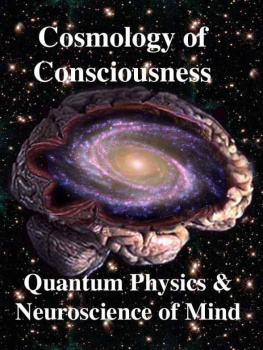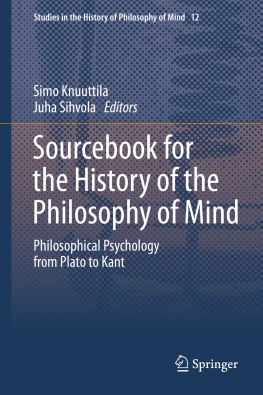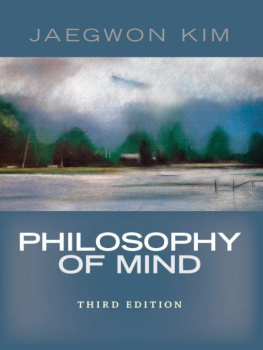
BY THE SAME AUTHOR:
Novels:
The Island Survival Guide
The Passage
Archipelago Republic
End of the East
The Secrets of the Lands Without
Plays:
Y
Baby
Turing
IN OUR
OWN
IMAGE
>> <<
SAVIOR or DESTROYER?
THE HISTORY and FUTURE of
ARTIFICIAL INTELLIGENCE
GEORGE ZARKADAKIS

IN OUR OWN IMAGE
Pegasus Books LLC
80 Broad Street, 5th Floor
New York, NY 10004
Copyright 2015 by George Zarkadakis
First Pegasus Books hardcover edition March 2016
All rights reserved. No part of this book may be reproduced in whole or in part without written permission from the publisher, except by reviewers who may quote brief excerpts in connection with a review in a newspaper, magazine, or electronic publication; nor may any part of this book be reproduced, stored in a retrieval system, or transmitted in any form or by any means electronic, mechanical, photocopying, recording, or other, without written permission from the publisher.
ISBN: 978-1-60598-964-8
ISBN: 978-1-68177-107-6 (e-book)
Distributed by W. W. Norton & Company, Inc.
CONTENTS
I met my first robot when I was five. It was a warm summer evening in Athens when my mother took me to an open-air cinema close to our house. Only a month earlier the first men had landed on the Moon and the world was abuzz with space fever. Every kid wanted to become an astronaut. We would dress up in all kinds of oddments that looked vaguely space-like and pretend to bounce about in zero gravity. It was a no-brainer for the owners of the cinema to screen a film set in the distant future, where humans would casually visit stars on the other side of the galaxy.
The cinema was jam-packed. I recall the aroma of jasmine mixing with pungent popcorn and sweat, the chatter of people and of crickets, the uncomfortable chair, the excitement of going to the movies in the days when television was a luxury afforded only by a few. My mother and I were ushered to our seats as the lights dimmed. The spirited babbling of the audience ebbed. Loud music blasted out of the speakers. The dark screen flickered and became a window to another world: there was a spaceship that looked like a round pie, and men in shiny uniforms speaking a language I did not understand. As for the subtitles, I was too young to read them. Maybe it was somewhat premature of my mother to take me to that film; nevertheless, watching Forbidden Planet in Athens that night changed my life for ever.
I am told that in the following days I would scribble countless sketches of the one thing that had impressed me the most: Robby the Robot. I would draw him with his lights flashing, explaining to whomever had the patience to listen how they flashed when he spoke in his mechanical voice, waving his arms and running about. Without question, a mechanical thing that walked, talked and obeyed orders would make the ideal playmate. Moreover, with a super-strong robot following me around, who would dare bully me? I could return the favour by teaching him all the things I knew: how to kick a football through a window, how to chase cats, how to draw. We would be the best of friends, pals for life. Robby the Robot had me in his grip for days, and held me tightly therein well into my final years at school when I decided to become an engineer and build my own robot one day. And thats how my journey into Artificial Intelligence began.
And quite a journey it was, too, for I literarily had to pack my suitcases and fly to London to study at university. My choice of subject was Control and Systems Engineering, a discipline based on the theory of cybernetics as developed by the American mathematician Norbert Wiener in the 1940s.
Wiener is one of the demigods of Artificial Intelligence. Born in Missouri in 1894, he was a child prodigy who earned a degree in mathematics at the age of fourteen and a doctorate at seventeen. A polymath with an insatiable appetite for knowledge, Wiener studied philosophy as well as zoology, then travelled to Europe to learn from the most prominent mathematical celebrities of the early twentieth century: Bertrand Russell at Cambridge and David Hilbert at Gttingen. He was a pacifist who objected to scientists colluding with the military establishment. He moonlighted as a journalist for the Boston Herald, and believed that automation would improve standards of living and put an end to economic underdevelopment. Many apocryphal tales are told of him, particularly about his absent-mindedness. The one I like best is about when he returned home one day to find his house empty. There was a girl waiting outside, so he went up to her and asked her what had happened. She explained that the family had moved house that day. When he thanked her for the information, she replied, Thats why I stayed behind, Daddy!
Cybernetics, Wieners most important scientific legacy, is a unique synthesis of biology and mathematics that aims to understand how complex natural systems behave and evolve. Wieners big idea was that by studying how life solves problems such as, for instance, locomotion or information processing (things such as seeing or feeling) one could apply mathematics to mimic life and build automated engineering systems. Cybernetics envisaged a world in which we could decode nature and reproduce it by constructing a brave new civilisation, with self-regulating factories, therapies for every disease, robust economies, fair societies, and yes machines that thought.
As my studies in systems engineering progressed I became increasingly interested in computers and computer programming. This may sound obvious nowadays but when I started university in the early 1980s PCs were not widely available. Undergraduate engineers had to program analogue computers, large calculating machines that looked like old-fashioned telephone switchboards and which used cathode ray tubes to perform calculations. Programming these ugly behemoths was a very cumbersome exercise, as they were prone to many errors that were difficult to trace or rectify. There was, of course, a digital computer in our university, a Honeywell-built giant that took up most of the universitys basement, but direct access to it was strictly controlled. To use it one had to book a time slot of a few minutes several days in advance.
The advent of PCs changed all that forever. They empowered experimentation and fast learning. One could now quickly test ideas about automation without having to look like a mad scientist surrounded by flashing lights and scores of wires. By the time I graduated I had acquired a lot of experience in computer programming, and decided to go into research. Applying Wieners cybernetic concept to the field of computing, my PhD focused on automating the thought processes of medical doctors in intensive care units. This is an area of Artificial Intelligence that goes by the name expert systems. What these systems do is study the way human experts process knowledge and take decisions, then use logic to encode human decision-making in a computer. There are many potential benefits from such systems: imagine expert decisions that must be taken in the absence of human experts, in remote and dangerous places such as on a battlefield or in interplanetary space. Nowadays, expert systems are routinely used in a wide spectrum of applications from medical diagnosis, finance and engineering, to video games and communications.
As I worked on my research, I began to have my first doubts about automating human intelligence. There was something about programming that did not quite capture the way minds seemed to function. Something was amiss. To understand why one must first look at the two fundamental and interlocking ideas upon which automation rests:
Next page
